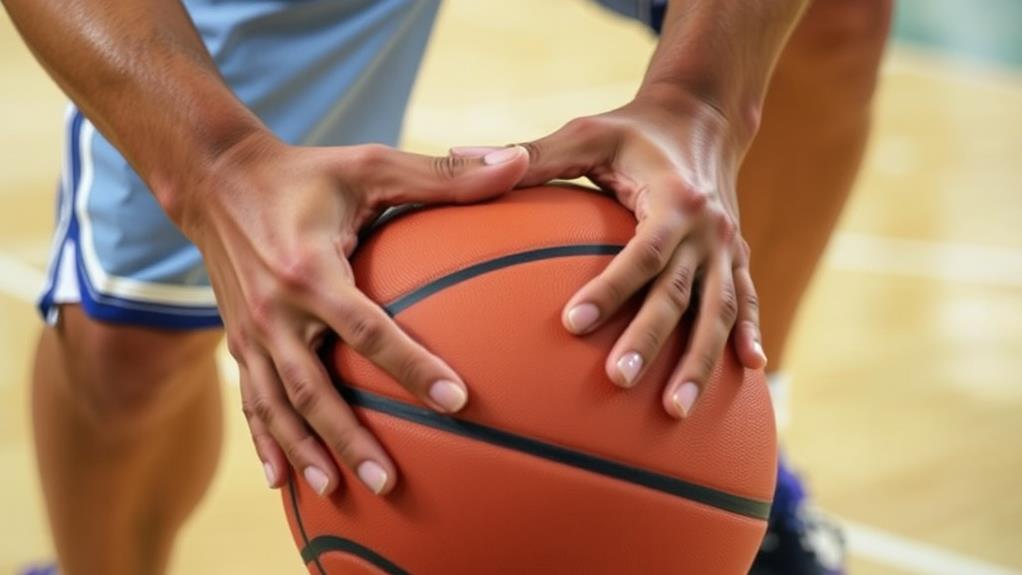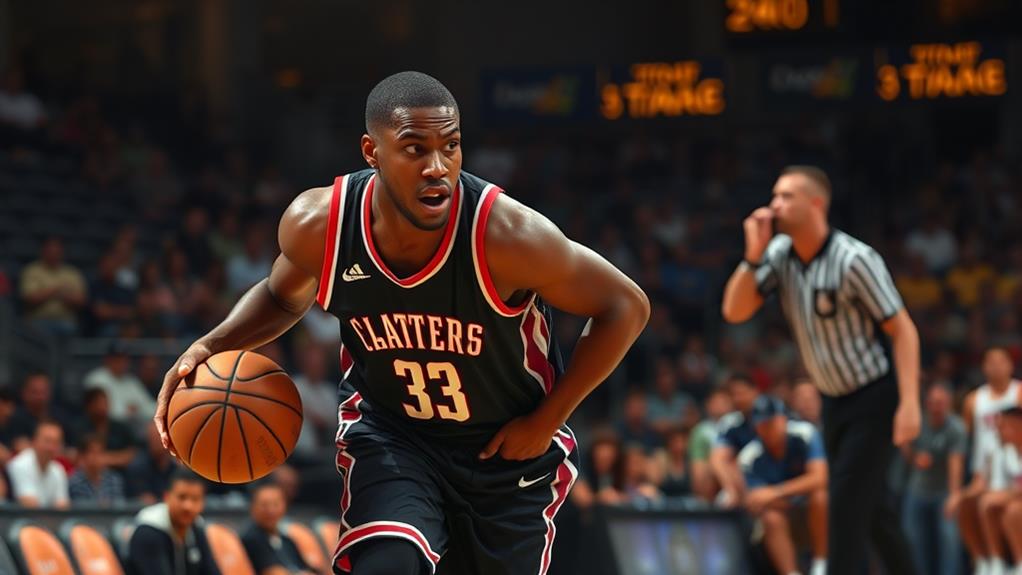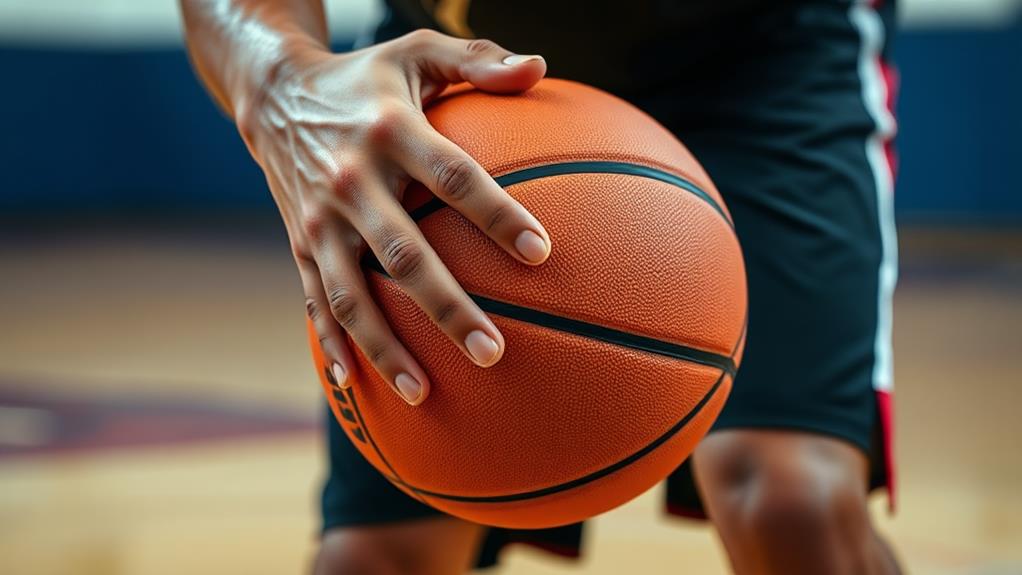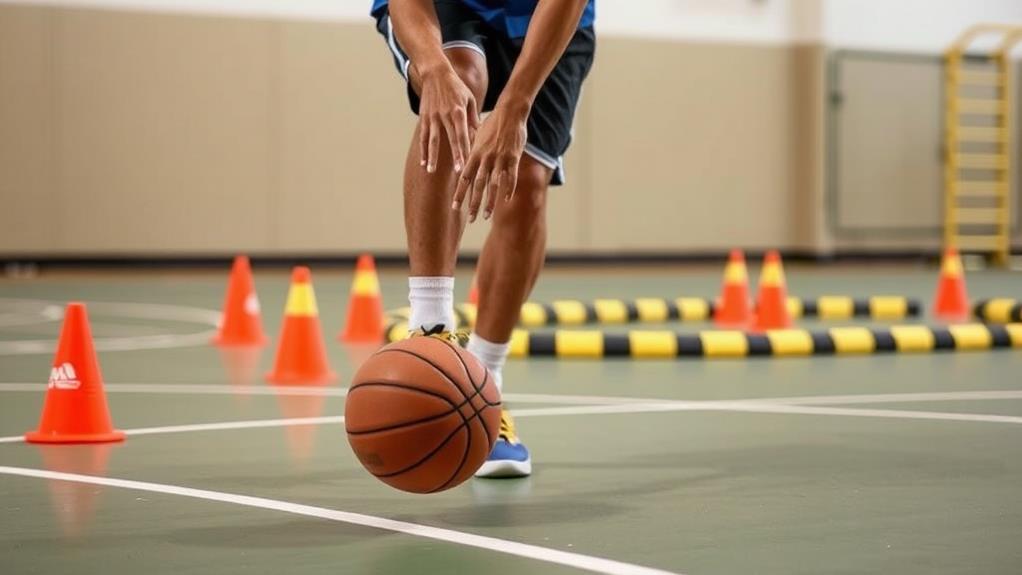
What Is a Carry in Basketball and How to Avoid It
September 28, 2024A carry in basketball happens when your hand goes beneath the ball while dribbling. This violation stops play and gives possession to the other team. To avoid it, make certain your palm faces down, keeping your hand above the ball throughout the dribble. Focus on using a low dribble and develop quick footwork to prevent hesitation. Regular practice with drills can also help you maintain proper hand positioning. Understanding these techniques will enhance your skills and guarantee smoother gameplay. There's more to learn about how to master your dribbling techniques effectively.
Understanding Carry in Basketball
In basketball, a carry is a violation that can catch even experienced players off guard. It happens when you dribble the ball with your hand underneath it, leading to a stoppage of play. This violation often occurs when you pause your dribble and then resume while still holding the ball, which sets it apart from a double dribble. According to NBA basketball rules, your hand shouldn't go under the ball while dribbling to guarantee fair play and prevent any undue advantages.
Maintaining fair competition is vital, much like the rules of player conduct in soccer.
Many players unknowingly commit this violation due to their dribbling technique. To avoid carrying, focus on keeping your palms facing down while you dribble. Make certain you maintain control of the ball throughout your movements, avoiding any pauses or hesitations that might trigger a carry call.
Practicing a fluid dribble can help you stay aware of your hand positioning and prevent this common mistake. Remember, the key is to keep the ball moving and stay conscious of how you're handling it, allowing you to play confidently without falling into the trap of a carry.
Rules Surrounding Carrying
When you're playing basketball, understanding the rules surrounding carrying is essential to avoid turnovers. The NBA strictly enforces these rules, so knowing what constitutes a carry can keep you in the game.
Maintaining proper dribbling technique is vital; for instance, players should be aware of effective player selection to enhance their skills on the court.
Watch out for common mistakes like letting your hand drop below the ball while dribbling.
Definition of Carrying
Carrying is a violation that can quickly change the momentum of a basketball game. In the NBA, it occurs when a player dribbles while their hand is under the ball, leading to a dead-ball turnover. Understanding carrying is vital for every player to avoid unnecessary mistakes and maintain control of the game.
Here are some key points to remember:
- A player can't pause their dribble and then resume while holding the ball; that's considered carrying.
- The hand must stay above the ball during the dribble; dropping the hand below indicates a violation.
- Referees are trained to spot this by observing the player's hand position.
- Distinguishing between carrying and other violations, like double dribble and traveling, is imperative for improving your ball-handling skills.
Enforcement in NBA
Understanding the enforcement of carrying violations in the NBA is vital for players and fans alike. The NBA defines a carrying violation as an illegal action where a player dribbles the ball while their hand goes underneath it. To avoid this, a player must guarantee that no part of their hand is under the ball during dribbling. The carry rule exists to maintain fairness and prevent players from gaining an unfair advantage in ball control.
When a referee identifies a carry, the game stops, and the opposing team is awarded possession of the ball at the nearest out-of-bounds line to the violation spot. Referees are trained to spot these violations by closely observing hand positioning and ball movement. This training helps guarantee consistent enforcement of the carry rule throughout the game.
Historically, the enforcement of carrying rules has varied, but the NBA has recently emphasized stricter adherence to maintain the game's flow and fairness.
For ball handlers, understanding and abiding by these rules is vital to avoid turnovers and maintain possession of the ball, ultimately impacting the game's outcome.
Common Mistakes to Avoid
A common mistake many players make is dribbling with their hand underneath the ball, which is a clear carry violation. To improve your dribbling skills and avoid committing this violation in basketball, keep these tips in mind:
- Don't pause your dribble. Resuming with the same hand can easily be interpreted as carrying by referees.
- Keep your palm facing down. This helps maintain control and prevents accidental carrying violations while you handle the basketball.
- Practice continuous dribbling. Hesitation invites mistakes, so focus on maintaining a steady rhythm to reduce the risk of a carry.
- Focus on footwork and body positioning. Proper stance enhances stability, preventing situations that may lead to carrying and giving your opponent an unfair advantage.
Consequences of a Carry Violation

What happens when a carry violation occurs in basketball? When you commit a carry, it results in a dead-ball turnover, meaning the opposing team gains possession of the basketball. In high school and college, they'll inbound the ball from the nearest sideline or baseline, while in the NBA, it's from between the free throw line and the baseline.
This can seriously disrupt your team's offensive flow, causing a loss of momentum that might lead to missed scoring opportunities. Understanding the rules, including key regulations, is crucial to avoiding such mistakes.
As an offensive player, accumulating carry violations can hurt your reputation on the court. Coaches and teammates may begin to lose confidence in your dribbling skills, which can negatively impact your overall performance during the game.
Each carry not only hands over possession to the other team but also puts additional pressure on you to avoid making the same mistake again. Ultimately, it's important to recognize the consequences of a carry violation, as it can affect your confidence and the dynamics of the game.
Stay aware and keep your dribbling in check to maintain your standing in the game of basketball.
Common Misunderstandings About Carrying
You might think that any time your hand touches the ball while dribbling, you're committing a carry, but that's not the case. Many confuse legal dribbling techniques, like the pocket dribble, with carrying violations, leading to unnecessary frustration.
Understanding the clear differences between these concepts is vital for improving your skills on the court. Recognizing the nuances of dribbling is essential, especially with the evolution of defensive strategies that demand players to be adaptable and skilled in their movements, as seen in informed defensive schemes.
Misinterpretation of Dribbling Rules
Many players often misinterpret the rules surrounding dribbling, particularly when it comes to carrying the ball. Understanding these nuances can help players avoid unnecessary carrying violations. Here are some common misunderstandings:
- Lifting the Dribble Hand: Many believe that if the hand goes under the bottom of the ball momentarily, it's not a carry. The rule states that a player can't lift their dribble hand off the ball in such a manner.
- Pausing in Dribbling: Some players confuse a pause in dribbling with a double dribble. While a double dribble is a separate violation, carrying specifically involves the hand's position under the ball during a legal dribble.
- Pocket Dribble Confusion: Players often mistake the pocket dribble for carrying. Skilled dribbling allows players to execute this technique without breaching the rules.
- Youth Player Misinterpretations: Youth players frequently misinterpret carrying due to their developing skills, often leading to calls based on improper hand positioning.
Skills Vs. Violations
Understanding the fine line between skilled dribbling and carrying violations is vital for any player looking to improve their game. Many players confuse the carrying rule with skilled dribbling techniques, like the pocket dribble, where you maintain control without placing your hand under the ball.
It's important to remember that a mere pause in your dribble doesn't automatically mean you're carrying. Legal dribbling allows quick changes in pace and direction, as long as the ball stays in motion.
The distinction between carrying and a double dribble can also be unclear. A carry happens when your hand is under the ball while dribbling, whereas a double dribble occurs when you stop your dribble and then resume it.
Players who carry often don't realize they're violating the rule, leading to confusion, especially in youth basketball. Critics argue that referees overlook these violations, which adds to the misunderstanding.
To avoid unintentional carrying violations, focus on proper dribbling mechanics. Keep your palms facing down and maintain a continuous motion.
Mastering these fundamentals makes all the difference in your game and helps you stay within the rules.
Techniques to Avoid Carrying

While dribbling, maintaining control of the ball is essential to avoid carrying violations. Effective ball handling is a vital aspect of enhancing player performance on the court, as it allows for precise movements and efficient gameplay.
Here are some effective techniques to help you keep the ball in check:
- Hand Positioning: Make sure your hand stays on top of the ball, with your palm facing downwards. This prevents the ball from resting in your hand and reduces the risk of a carry.
- Low Dribble Technique: Practice keeping the ball close to the ground while dribbling. This minimizes the chance of your hand going underneath the ball, which can lead to a carry.
- Quick Footwork: Develop quick and controlled footwork to avoid hesitation during dribbling. Remember, pauses can lead to carrying violations, so keep moving!
- Drills for Continuous Movement: Incorporate drills like zig-zag dribbling or cone drills. These exercises reinforce proper handling and help you avoid carrying when you're in high-pressure situations.
Regularly filming your dribbles can also help you identify improper hand positioning, allowing you to make necessary adjustments.
Defensive Strategies to Force a Carry
To effectively counteract good ball handling, implementing defensive strategies that pressure the ball handler can create opportunities for carrying violations. One effective method is to apply aggressive on-ball defense. By doing so, you force the player to make quick decisions, increasing the likelihood that they'll carry the ball. When a defender disrupts an offensive player's rhythm, it can lead to confusion, making it easier for them to commit a carry.
Additionally, mastering interception and anticipation can help defenders predict the ball handler's movements, further increasing the chances of forcing a carry.
Utilizing strategic double-teaming can also help. When two defenders pressure the ball handler, it forces them to rethink their dribble. Position yourself to cut off potential driving lanes; if the player hesitates or loses control, they may carry the ball.
Encourage constant movement and switching among your defenders to keep the ball handler off-balance. If they're not able to keep the ball high enough or maintain proper technique, you've got a better chance of forcing a carry.
Resources for Skill Development

How can players enhance their skills to avoid carrying violations? Focusing on skill development is vital, and there are several resources to help you refine your game. Here are four effective ways to boost your ball handling and dribbling techniques:
- HoopsKing Training Programs: These specialized coaching sessions zero in on ball handling, helping you grasp the nuances of dribbling while avoiding carrying infractions. Utilizing data-driven strategies can also optimize your training sessions for maximum efficiency in skill acquisition, as seen in impact of analytics on player performance.
- Skill Development Workshops: Attend workshops that explore basketball rules and provide practical drills. This will deepen your understanding of carrying violations and improve your overall gameplay.
- Dribbling Drills: Incorporate stationary and cone drills into your practice. These exercises emphasize proper hand positioning and continuous dribbling, essential for preventing carrying violations.
- Online Resources: Take advantage of instructional videos and guides available online. Many platforms offer content specifically designed to enhance your dribbling techniques and reduce the risk of carrying.
Engaging with coaches and participating in local basketball leagues or camps can further enhance your skills. Community engagement fosters an environment of learning and improvement, ensuring you stay sharp on the court.
Conclusion
In basketball, mastering the mechanics of movement matters. By staying sharp and practicing proper techniques, you can sidestep the sneaky snares of carrying. Embrace the elegance of efficient dribbling, and you'll elevate your game while evading errors. Keep your head up, your feet light, and your focus fierce. Remember, with dedication and diligence, you'll dodge the dreaded carry, ensuring your skills shine on the court. Stay smart, stay swift, and soar to success!


